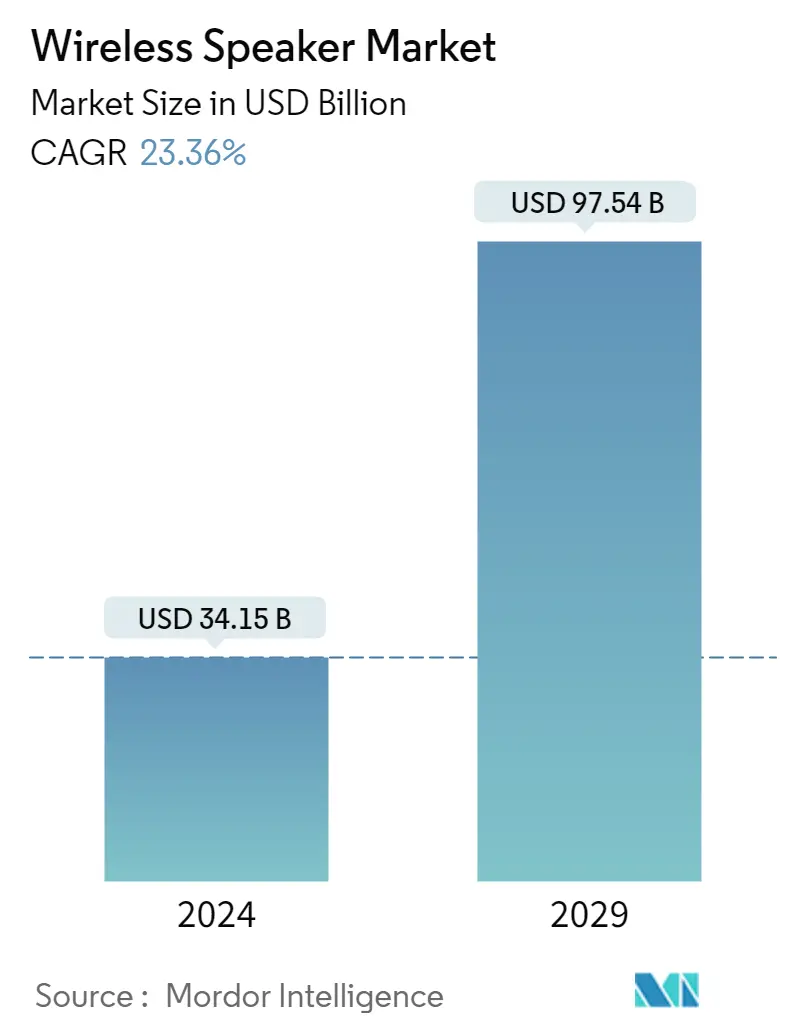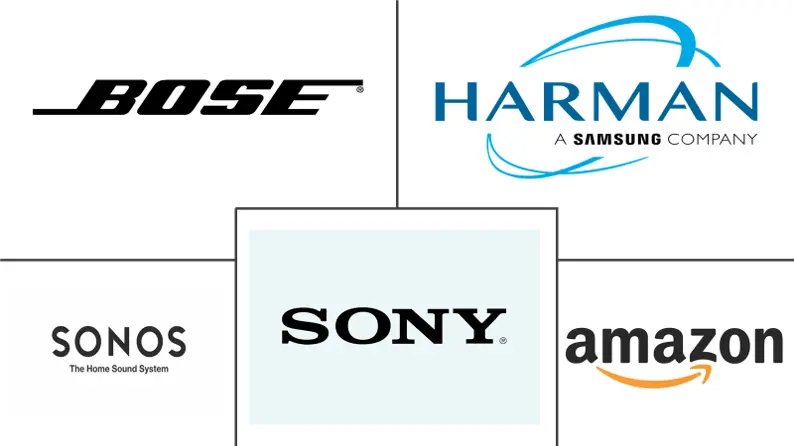Market Size of Wireless Speaker Industry

| Study Period | 2019 - 2029 |
| Market Size (2024) | USD 34.15 Billion |
| Market Size (2029) | USD 97.54 Billion |
| CAGR (2024 - 2029) | 23.36 % |
| Fastest Growing Market | Asia-Pacific |
| Largest Market | North America |
Major Players
*Disclaimer: Major Players sorted in no particular order |
Need a report that reflects how COVID-19 has impacted this market and its growth?
Wireless Speaker Market Analysis
The Wireless Speaker Market size is estimated at USD 34.15 billion in 2024, and is expected to reach USD 97.54 billion by 2029, growing at a CAGR of 23.36% during the forecast period (2024-2029).
The growing investment in the smart home segment, increasing preference for portable speakers, and increasing product innovations in the wireless speaker segment are some of the major factors driving the adoption of wireless speakers. Due to the high rate of product innovation in the studied market, most wireless speakers now come at affordable prices. They are convenient to use, which is further creating opportunities in the studied market.
- The growing trend of smart speakers globally, mainly due to the trending feature of voice assistants, is further developing space for wireless speakers. In recent years, the growing investment by millennial users in the speakers market and their preference for convenient and easy-to-carry devices have forced global speaker manufacturers to shift to wireless technology from wired speakers. Initially, most market vendors target millennial users who like to carry their speakers around while playing music. Companies like Google and Amazon have been increasingly targeting this customer base recently. Market vendors also provide additional features such as splash resistant or water-resistant to attract more customers.
- Although, presently, Bluetooth speakers account for a significant market share in many regions; however, the trend is mainly shifting toward Wi-Fi speakers. Features like latency, reliability, direct connection to the internet, and multiple modes are some of the advantages of Wi-Fi speakers over Bluetooth reported by many customers. Companies like Sonos are selling Wi-Fi speakers that support audio up to 16-bit depth, 1,536kbps bitrate, and 48 kHz sample rates above the CD-quality level. An initiative like the Wireless Speaker and Audio Association (WiSA), consisting of more than 60 electronics companies, promotes standards and high-resolution audio across wireless speakers, further supporting product innovation in the market.
- Furthermore, various technological innovations are witnessed in the Bluetooth connectivity space to enhance quality and privacy further. For instance, in March 2022, Sonos upgraded its bluetooth speaker. The new Sonos Roam SL removes the microphones from the original Sonos Roam speaker, which means the user won't control it with voice or use it to manage other smart home devices.
- Market vendors like Sonos recently launched Sonos Radio, a free, ad-supported streaming radio experience that brings 60,000 global stations to the sound system. This is also driving the demand for wireless speakers. Google Home Max, Amazon Echo Dot 3rd Gen and JBL Link 10 are some wireless smart speakers with AI technology. It was expected that end-user spending on virtual personal assistant-enabled wireless speakers would be estimated to cross USD 3.5 billion last year.
- Furthermore, recently, Dixon Technologies signed an agreement with Imagine Marketing, the famous boAt wearable electronics developer, to manufacture twin wireless speakers. Dixon will manufacture the products at its manufacturing facility in Noida, Uttar Pradesh. Establishing such developments will further drive market growth.
- COVID-19 impacted the market significantly. Asian countries such as China, India, South Korea, Taiwan, and Japan, which have a significant presence of manufacturers of the raw materials used in wireless speaker manufacturing, experienced lockdowns and disrupted production schedules. The sales were down as the lockdown in most global economies resulted in deliveries limited to essentials and companies revising their revenue targets. However, in many countries, the smart home segment products witnessed increased demand after the ease of the lockdown.
